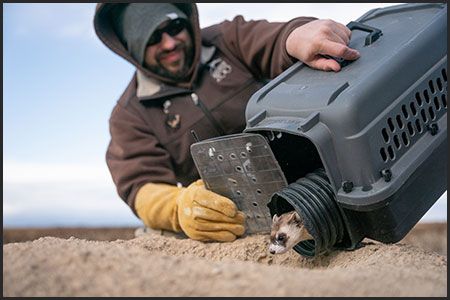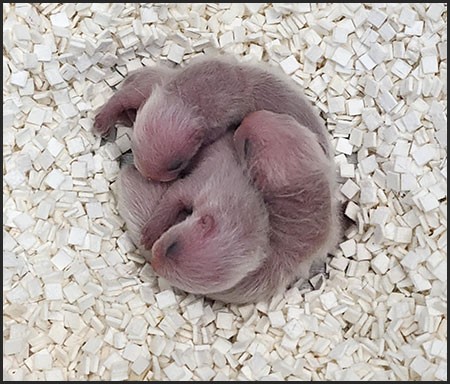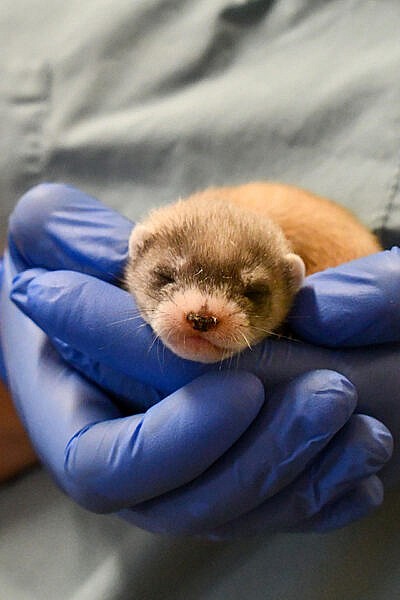Cheyenne Mountain Zoo’s dedicated team of black-footed ferret conservationists are helping rewrite the narrative of recovery from extinction, one litter at a time. Following last year’s record number of kits born, program-wide in over a decade, CMZoo’s conservation team is celebrating its own record year, and trying something new.

This summer, CMZoo welcomed the most black-footed ferret (BFF) kits born in a single season: 37. It could have been luck. It could have been the crisp mountain air and a snowy winter. Or, it could have been the multiple-partner breeding trial.
“We’re trying to replicate opportunities observed in nature, when female black-footed ferrets mate with multiple mates within the same breeding window,” Jeff Baughman, field conservation coordinator at CMZoo, says. Jeff has been part of CMZoo’s black-footed ferret and Wyoming toad breed-and-release programs for more than 20 years. “Mixed paternity litters are not unheard of in various species in the wild. But, this is the first time we have tried it at CMZoo. We want to learn if it’s possible for black-footed ferret mothers to whelp kits by different fathers in the same litter.”
BFFs are induced ovulators, meaning the act of breeding triggers ovulation which lasts around 72 hours. In the past, a female has been paired with a suitable male for the full 72 hours. In this trial, a female is paired with a male for the first 24 hours, then a different male for the next 24 hours, and a third male for the last 24 hours.
BFFs have incredibly few breeding opportunities. Females are only typically reproductive from 1 to 4 years old, and they only breed once per year – in that 72-hour window.
The team hopes to run paternity tests on the kits by mid-August, because their genetics play a role in deciding which kits go to boot camp for potential eventual wild release. It’s not just for all of the potential Maury Povich ‘you are the father!’ puns, which will be admittedly hard to resist. If this trial shows that females can have mixed paternity litters, this method could be a new tool for increased diversity in critically endangered species over time.
Conservation is a commitment, a collaboration and a healthy compromise. There are many partners involved in the efforts to help BFFs recover in the wild. Led by the Association of Zoos and Aquariums (AZA) Black-Footed Ferret SAFE (Saving Animals From Extinction) and U.S. Fish & Wildlife Service (USFWS), Cheyenne Mountain Zoo is one of only five zoos in the world supporting black-footed ferret recovery. Partners at Toronto Zoo, Louisville Zoo, Phoenix Zoo and Smithsonian Conservation and Biology Institute along with the USFWS National Black Footed Ferret Breeding and Conservation Center just outside of Fort Collins, Colo., are actively involved in breeding, genetic tracking, releasing and advocating for the little weasels.
“We’re all passionate about it and when we agree, as a collective, to change methods or try new things, it’s definitely a process,” says Jeff. “Some people wonder why we invest so much energy to saving this species. They’re not only cute; they’re vital in helping secure healthy prairie ecosystems, right here in Colorado and across North American prairies.”

BFFs are predatory prey, so their environmental role is to help control prairie dog populations while occasionally being a food source to owls, coyotes and badgers. Designated BFF reintroduction sites are managed for fleas that can transmit plague, which supports healthy prairie dog populations. This safeguards all of the other prairie species that rely on prairie dogs (a keystone species) as well. Black-footed ferrets are rare and important because they serve the ecosystem up and down.
Native to prairies stretching from Mexico to Canada, BFFs were thought to be extinct until the 1980s. During Western frontier explorations in the early 1900s, cargo ships from Europe and Asia inadvertently brought sylvatic plague to North America. The spread of the plague bacteria by fleas among prairie dogs (and other animals), combined with poisoning and eradication programs led by newly settled farmers and ranchers who saw prairie dogs as pests, drastically reduced the prairie dog population. Because prairie dogs are their main food source, BFF populations declined dramatically along with them.
On Sept. 26, 1981, a ranch dog named Shep caught a BFF. Shep’s catch led to the discovery of a small population of the elusive animals in Meeteetse, Wyoming. Since then, zoos, U.S. Fish and Wildlife, National Black-footed Ferret Conservation Center and other organizations have banded together to breed, prepare, release and monitor BFFs to increase the population.
Since 1991, when CMZoo’s BFF breed-and-release program began, 647 kits have been born on the mountain. Some of the most genetically diverse kits stay in human care, as part of the breeding program, so they can pass on their underrepresented genes to another generation. Others go to boot camp, to see if they can cut it in the wild. Of those, some are released and some – who do not prove they can hunt, seek shelter and protect themselves in the wild – return to serve their species as ambassadors in zoos and other educational settings. Numbers fluctuate, but recent reports estimate 350 BFFs are thriving in the wild, thanks to this program.
“It’s exciting to have been involved with this program for so long, and now to be able to do preliminary trials that could teach us how we can best support black-footed ferret wild recovery,” Jeff says. “Who knows? When the paternity results come back, we could find out it was just a really good breeding year, and there weren’t any mixed paternity litters. That’s part of the excitement of a trial. What’s next remains to be seen, and we will stay inspired to continue helping restore this species to our wild prairielands.”

